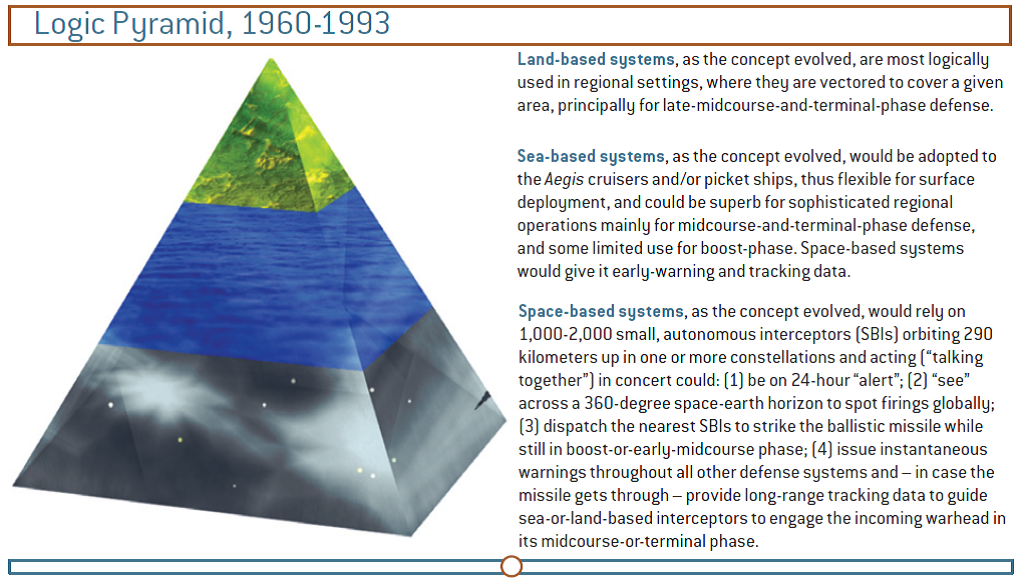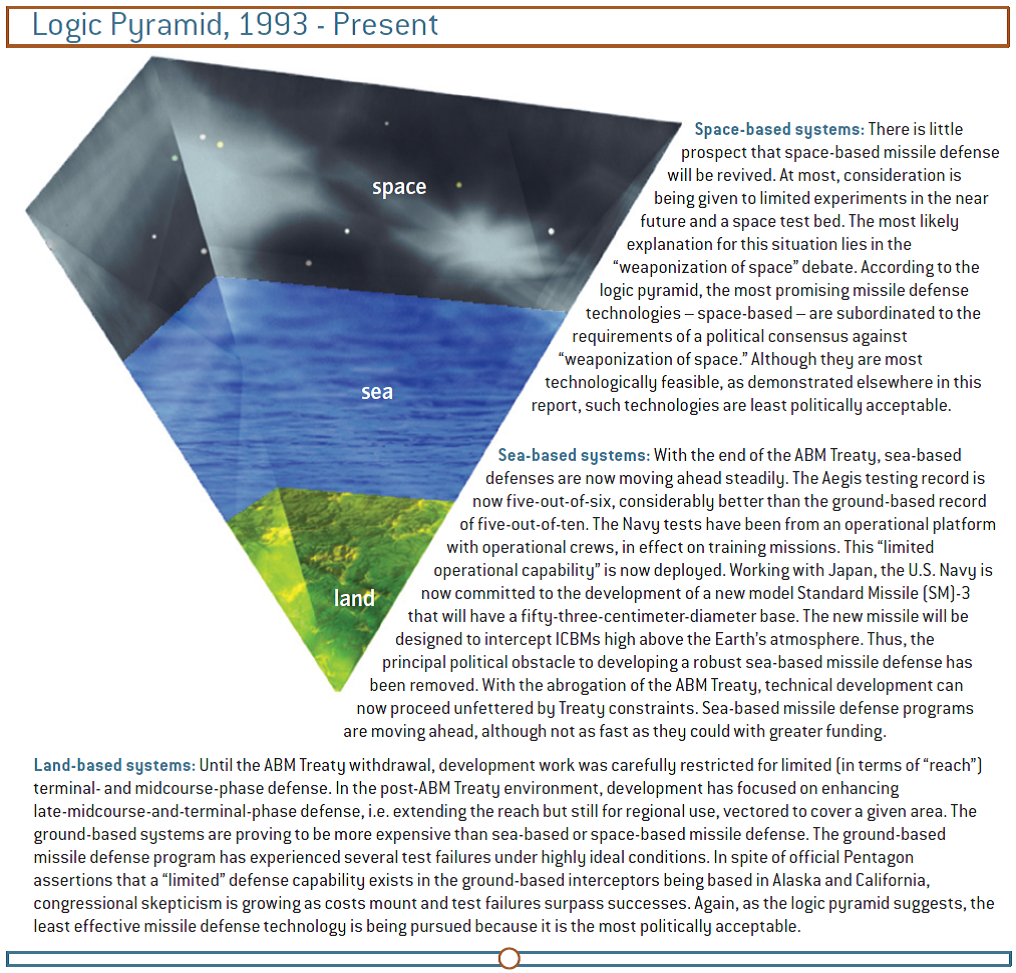Last month, many of us remembered President Reagan’s March 23, 1983 speech that launched his Strategic Defense Initiative (SDI), which many remember as playing a crucial role in ending the Cold War. What is seemingly forgotten is the important role that space-based defenses played in realizing Reagan’s vision — and, even more important, their potential benefits for today. A challenge for Trump’s Space Force!
Reagan’s speech and his subsequent SDI challenged America’s best and brightest scientists and engineers to conduct extensive research to determine if truly effective ballistic missile defense (BMD) systems could be built. Within the next decade, the answer was clearly an emphatic, “Yes!”
But since then, we have only seen a partial demonstration of the validity of that conclusion. Indeed, the SDI program succeeded, and not just in generating the ballistic missile defense (BMD) systems we have today.
Even more important in my view, it demonstrated that the most cost-effective BMD systems, based in space, could realize Reagan’s vision reflected in his question, “Wouldn’t it be better to save lives than to avenge them?” This question reflected Reagan’s strong distaste for the Mutual Assured Destruction (MAD) doctrine that had previously been the primary U.S. strategy for deterring a nuclear attack.
This MAD strategy was reinforced by the Anti-Ballistic Missile (ABM) Treaty that banned the development, testing and deployment of space-based, air-based and mobile land-based defenses to protect the American people. The George H.W. Bush administration continued the Reagan SDI focus and approach, but they were abandoned by the Clinton administration.
Defense Secretary Les Aspin most emphatically emphasized this purposeful decision when he scuttled Reagan’s SDI program and completely gutted its space-based interceptor efforts, while memorably declaring that he “Took the stars out of Star Wars.” And the Clinton administration declared its allegiance to the ABM Treaty as the “cornerstone of strategic stability,” reversing the views of the Reagan and GHW Bush administrations.
Then eight years later, when President George W. Bush withdrew from the ABM Treaty, I cheered and hoped to see a revival of those most important SDI programs. But I was also disappointed, to say the least, with that 8-years. And of course, the Obama administration did nothing to revive them either during its 8-years.
So — after almost three decades, the important potential of space-based interceptor capabilities have fallen by the wayside. Regrettably for reasons I do not understand, they also seem to be forgotten or at least currently unstated by the powers that be in the Trump administration.
This situation is reflected in a recent Forbes article by Loren Thompson that emphasized the concerns about the hypersonic weapons threat. Click here for that excellent article, except that there was no reference to space-based interceptors — even though it referred to the important role that could be played by space-based sensors.
It would be relatively easy to make sure those satellites also carry the right sensors and host miniature “rockets” to maneuver into the path of threatening Ballistic missiles, including in their “boost phase.” Click here for my Newsmax article yesterday that goes further in discussing this Forbes article and what should now be done to revive the Brilliant Pebbles space-based interceptor system.
Now, we await to the outcome from how the Pentagon and Congress as they consider various initiatives intended to help realize President Trump’s proposed new Space Force — intended (eventually???) to be an entirely separate sixth service. In particular, we’ll be looking for whether Thursday’s Senate Armed Services Committee Hearing on the Space Force Initiative sheds any light on the important question. Click here for information on that important hearing.
From my perspective a most important consideration is whether there will be the rapid development of a space-based interceptor system that we well understood how to build three decades ago — within five years.
The important thing is to remember that the Pentagon lost Reagan’s vision, which emphasized employing the best technology America could produce without precluding any possibility, whatever the prior political correctness constraints. And “Brilliant Pebbles”—the most cost-effective product of the SDI era—was abandoned for political not technological reasons.
This assessment reflects the views of the SDI Directors of the “the SDI era”—1983-93 — as well as the first BMD Director of the Clinton administration that gutted the SDI program. And it survived a major “season” of very critical technical reviews that led the Pentagon’s Defense Acquisition authorities to approve in 1990 for Brilliant Pebbles to enter a formal demonstration and validation (DemVal) program.
Click here for my January 22, 2019 detailed review of this important background.
Understand, the problem is much, much more than a lack of money!
Politics, not technology or expenses, has stood in the way of building the most effective BMD systems; we knew how to build them 30-years ago. Consider the following discussion for further insights to how politics have blocked building the best defenses our technologists knew how to build — and help make sure we don’t see a repeat performance.
Politics Blocked the Best Technical Solutions!
These issues were dealt with by our Independent Working Group (IWG) that carefully considered “Missile Defense, the Space Relationship & the 21st Century.” Click here for our intensive review. We concluded in 2007, and updated in 2009, that since 1993 we have not invested in the most effective, least costly BMD system concepts — those based in space.
I strongly encourage you to read Chapters 4 and 5 to better understand this political morass, illustrated by what I’d refer to as “McMichael’s Pyramids” after Mr. R. Daniel McMichael who was their principal author. I urge all to read at least Chapter 4 (pages 52-72) for his “Historical Analysis of the Politics Against Missile Defense.”
McMichael’s first figure below illustrates the evolution of “preferred, politics-free” technological possibilities from the studies of BMD systems concepts from the early Defense Advanced Project Agency (DARPA) studies of the 1960s though the SDI era (March 23, 1983-January 20, 1993).
The DARPA studies in the 1960s recognized that space-based defenses could eventually be the most cost-effective way to provide a global defense that could intercept ballistic missiles in all their phases of flight, beginning in their boost-phase before the effective countermeasures of concern today could be deployed.
SDI studies demonstrated in 1989-90 that such boost-phase defenses were finally technologically feasible.
Moreover, multiple subsequent intercept opportunities would also occur during the longer attacking missile’s flight toward its target, provided the anticipated “midcourse offensive countermeasures” could be defeated.
And as SDI efforts demonstrated, intercept opportunities would also exist after the attacking missile components re-enter the atmosphere in its terminal phase.
Such space-based systems would be the technologically-based foundation for an effective global defense and the base of McMichael’s pyramid — if technology can support that architecture.
At the time of the 1960s DARPA study, the technology would not support such a system; but by 1989-90 it could, according to the Pentagon’s Defense Acquisition officials.
Had we continued development of such space-based systems, they would be available today to intercept ballistic missiles of all ranges greater than a few hundred miles — launched from anywhere on earth toward any other target.
The next most effective global defense would be sea-based because most of the earth’s surface is water, and so sea-based defenses between the launch site of threatening ballistic missiles and their targets could have numerous intercept opportunities while the attacking missile flies on its trajectory through outer space—the “exo-atmospheric” midcourse phase of its flight trajectory.
Least flexible would be ground based defenses which cannot easily get near threatening launch sites, and so generally are restricted to being located near the area to be defended. This is a main reason why our defenses today are ineffective against Vladimir Putin’s hypersonic “boost-glide” Avangard system.
When all basing modes are available, the optimum arrangement of a global defense would:
- Place top priority on basing the defense in space that can intercept ballistic missiles in their boost phase as well as throughout their flight trajectory;
- Next priority for sea-based defenses focused on mid-course portion of the threatening trajectory, beginning in its ascent phase; and
- Finally on terminal land-based defenses focused on the final stage of the threatening missile trajectory.
By 1993, thanks to President Reagan’s SDI program, the technology demonstrated that cost-effective space-based defenses were feasible—indeed the Brilliant Pebbles program was formally approved in early 1990 by the Pentagon’s Defense Acquisition Authorities to enter the Concept Validation Phase.
Its formally derived cost-estimates of $10 billion (in 1988 dollars — now inflated to $20 billion in today’s dollars) for acquiring, deploying, operating in orbit, and replacing once each of 1000 Brilliant Pebbles interceptors.
Click here for the February 1991 briefing to the press by then Assistant Defense Secretary Stephen Hadley’s and me, announcing my redirection of the SDI program to pursue what I still believe is the right answer for a global defense—we called the concept GPALS for Global Protection Against Limited Strikes. (Rotate the charts for ease of reading.)
Notably, we introduced the possibility of sea-based defenses — and the Navy became supportive of including that concept in the theater missile defense (TMD) component of GPALS.
So, by the end of the Bush-41 administration, we were on a track to provide the national authorities the option of building an effective global defense according to McMichael’s logic pyramid pictured above.
This was Reagan’s legacy when I left the picture as SDI Director on January 20, 1993.
After then, political concerns dominated the picture — and turned McMichael’s pyramid on its head, as illustrated below, which regrettably is where we remain.
The Clinton administration focused its top priority on “strengthening” the Anti-Ballistic Missile (ABM) Treaty as the “cornerstone of strategic stability” rather than building truly cost-effective BMD systems.
How McMichael’s Pyramid Was Inverted.
Actually, the regression began during the later days of the Bush-41 administration when congressional leaders demanded that demanded that the priority be placed on ABM Treaty-compliant ground-based missile BMD systems — the least effective component of the technological logic pyramids — at the expense of the investments in the other components — especially the most effective component of the technological logic pyramid.
But, thanks to some stalwart SDI supporters in congress, over $300 million was appropriated for FY 1993 (inflates to over $500 million today) for continuing a technology demonstration program for space-based defenses. (Compare that with the lethargic amount of funding proposed for 2020 in support of anything approaching this system concept.)
However, when Mr. Aspin migrated from his seat as Chairman of the Armed Services Committee to the Pentagon as Secretary of Defense, even that technology demonstration effort was cancelled and all related advanced technology programs ended — and the professionals who had been working in this area were dispersed — and the associated SDI files were purged.
Happily, bi-partisan congressional support continued for developing sea-based theater missile defenses then in its infancy, so at least the next most technologically desirable basing mode continued and is quite mature today, though not at the pace I had hoped and thought possible 30 years ago.
I would note that the above 2009 chart is dated — the Aegis BMD system has now been deployed on 38 BMD Destroyers and BMD Cruisers and in a ground-based configuration in Romania and Poland — and is to be deployed in Japan, Hawaii and perhaps other places.
Whatever, politics prevailed and so far essentially nothing has happened on space based defenses. Stay tuned for Thursday’s SASC hearing.
Bottom Lines: Opportunities for Going Back to the Future.
I am proud that the Aegis BMD system that began on my SDI watch is now deployed around the world, and hope to see ground-based “Aegis Ashore” version deployed on several such sites around the Gulf of Mexico to defend against ballistic missiles launched at us from the South — e.g., from vessels in the Gulf.
We should make it “all it can be” by exploiting the technology artificially stifled almost 30-years ago when then Defense Secretary Aspin “Took the stars out of Star Wars.”
Most important is for President Trump to return to Reagan’s vision in which space-based defenses should play a major if not dominant role. To do so may still require outside pressures to influence many residual “powers that be,” who thus far have shown little sign of heeding the IWG conclusions and recommendations.
What can you do?
Join us in praying for our nation, and for a rebirth of the freedom sought, achieved and passed to us by those who came before us.
Help us to spread our message to the grass roots and to encourage all “powers that be” to provide for the common defense as they are sworn to do.
Begin by passing this message to your friends and suggest they visit our webpage www.highfrontier.org, for more information. Also, please encourage your sphere of influence to sign up for our weekly e-newsletter.
Encourage them to review our past email messages, posted on www.highfrontier.org, to learn about many details related to the existential manmade and natural EMP threats and how we can protect America against them. I hope you will help us with our urgently needed efforts, which I will be discussing in future messages.
Click here to make a tax deductible gift. If you prefer to mail a check, Please send it to 500 North Washington Street, Alexandria, VA 22314.
Please click here to read Past Weekly Updates!
Please help High Frontier continue this important and timely work!
Be sure to follow us on our Social Sites!
If you found this letter via our Social Sites, and you would like to subscribe, please click below!







